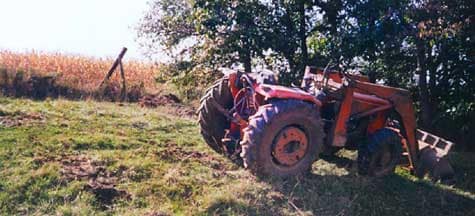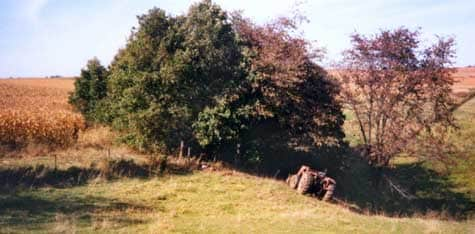Farmer Killed in Tractor Rollover While Setting a Fence Post
Iowa Case Report: 03IA056
Report Date: August 30, 2004
Summary
During the fall of 2003 a 60-year-old farmer was killed in a tractor rollover while putting in a fence post on his farm. He was working with his son, using the front bucket of his tractor to push a wooden fence post into the ground. The men were working in an area of pasture which had a slight slope to the right front of the tractor. The son was holding the 6-inch post upright, while his father on the tractor positioned the front bucket, half-filled with dirt, on top of the post. They were using the hydraulics of the tractor to push and/or ram the post into the ground, a procedure successfully completed with “thousands of fence posts” on their farm without apparent problems. However, that day the ground was fairly dry, and the post did not penetrate the soil more than six inches. Suddenly, the bucket slipped off the post, and the bucket snapped downward with sufficient force and momentum that it caused the rear of the tractor to lift up. The wide-front tractor then rolled over on its right side down the slope, stopping momentarily, then continuing to roll until it had righted itself again, as seen in Photo 1. The farmer was fatally crushed as the tractor rolled over, and was found on the ground to the left of the machine. There was no ROPS on the tractor.
 |
|
Photo 1 – View of the scene showing the fence being repaired, the sloping pasture, and the up-righted tractor.
|
Recommendations based on our investigation are as follows:
- All tractors should be equipped with Roll Over Protective Structures.
- Factory installed Roll-Over Protective Structures (ROPS) should not be removed from tractors.
- Alternate methods of installing fence posts should be considered.
 |
|
Photo 2 – Long shot of the entire scene, showing the slope of the pasture and the up-righted tractor.
|
Introduction
During the fall of 2004, a 60-year-old farmer was killed while operating a tractor in his pasture. The Iowa FACE Program was notified of this incident a few days later, and began an investigation. Information was gathered from the county sheriff, the state medical examiner, newspapers, and the victim’s son, who was an eyewitness of the event. Photographs were also obtained from the county sheriff.
The victim had been a full-time farmer for the past 35 years, and lived on a 140-acre farm, growing corn, beans, and hay. He also had 140 milk cows and raised an additional 200 head of cattle. The man farmed with his three sons, and occasionally hired part-time laborers when needed. The farmer was working with one of his sons on the day of his death.
This small family farm did not have any safety program or written policies in place, which is typical for many small family-owned businesses. Family members grew up in the business and were well informed of safety issues and hazardous areas around the farmyard. Safety issues were discussed on a need-to-know basis and were job-specific. All men working on this farm were very familiar with the equipment and were experienced handling many types of farm machinery.
Investigation
At this farm there was a washout in a fence line that needed to be repaired. The farmer and his son drove a tractor to the area with a new wooden fence post, 5-6 inches in diameter and seven feet long. Their normal procedure was to use the elevated front bucket of the tractor to push or ram the fence posts into the ground. They had done this “1000s of times without any problem.” The bucket was partially filled with dirt, then, raised over the post, which was held in place while the bucket was forced down on its top, pushing or pounding the post into the soft ground.
The tractor used was a wide-front Massey Ferguson, model 274, with 4-wheel drive, which the farmer had bought new 15-20 years ago, equipped at that time with a factory-installed front end loader. This loader did have hydraulic power-down ability. For as long as the son could remember, this tractor did not have a ROPS (Roll Over Protective Structure), and the son was not sure when the ROPS had been removed. The tractor was used to clean sheds which had a low ceiling, and the ROPS was too tall for several of these areas. The farmer also had a skid-steer loader, but preferred to use his tractor to clean these areas. Also, the ROPS made it difficult to get around in timber, and it was evidently removed by the farmer many years ago.
The farmer partially filled the front bucket with dirt, then, positioned the tractor to put in the fence post, working in a pasture area, which sloped slightly to the right (see Photos 1, 2). As usual, the farmer was operating the tractor, while his son assisted by positioning the fence post. The middle of the front bucket was placed on top of the post, then, the post was pushed or rammed into the ground. But the soil in the area was rather dry that day, and the post could penetrate no more than six inches.
The men were unsuccessful and ready to quit, when suddenly, as the bucket was being forced down, the bucket apparently slipped off the post, and the heavy bucket, under hydraulic pressure, snapped in a downward direction. This momentum was sufficient enough to pop up the rear of the tractor, which, in combination with the slope in the area, caused the tractor to rollover to its right side. The tractor rolled completely upside down, then almost stopped, then continued to roll further to upright itself on its wheels, as seen in Photo 1. When the tractor first rolled, the farmer was crushed in the chest area by the frame for the front-end loader. He was not pinned by the tractor, but received fatal internal injuries, and was declared dead when taken to a local hospital.
Cause of Death
The official cause of death from the medical examiners report was, “blunt force injuries to chest due to tractor rollover.” An autopsy confirmed these findings.
Recommendations/Discussion
Recommendation #1: All tractors should be equipped with Roll Over Protective Structures.
Discussion: Using Roll Over Protective Structures (ROPS) is a proven method of reducing deaths from tractor overturns. All tractors manufactured in the USA after 1986 have factory-installed ROPS, but about half of tractors in the United States still do not have ROPS. For the majority of functioning older tractors, ROPS are available at fairly reasonable cost, yet some tractors do not have any options for adding a ROPS.1 Risk factors for overturns include using a front-end loader, narrow front (tricycle design), and using the tractor for mowing on sloping ground. In fact, any type of tractor activity on sloping ground is hazardous, and tractor operators must always be alert.
Tractor owners / operators cannot anticipate every hazardous situation that may arise in a typical workday. Even in the best of circumstances, the unexpected can, and does happen, and workers are often injured when caught off guard. The victim in this case was using a very familiar tractor in a very familiar setting, apparently fully aware of the slopes and overturn risks on his farm. Placing fence posts with a tractor was never thought to be a hazardous activity, and the rebound downward force of the heavy bucket was completely unexpected, and probably unimaginable. These facts underscore the importance of Roll-Over Protective Structures, for if this tractor had a ROPS installed, it would have prevented a complete rollover, and likely saved this man’s life.
Recommendation #2: Factory installed Roll-Over Protective Structures (ROPS) should not be removed from tractors.
Discussion: Many times tractor owners or farmers remove the factory-installed ROPS to facilitate operation in buildings with low clearance, or working in orchards and timber, or for other reasons. Most tractors have a high center of gravity, which increases the likelihood of tipping over on sloping ground, and usually causes the tractor to roll completely over (180 degrees), rather than simply falling over on its side. Using an approved ROPS and seat belt provides a protective zone around the operator, and in most cases, will prevent the tractor from overturning completely. Serious injuries may still result from a rollover with ROPS installed, but fatal injuries are seldom seen. There are ~ 4.7 million tractors in the U.S., and about half of these do not have a ROPS. Since 1985, however, manufacturers have included ROPS on all new tractors sold in the U.S. In some countries, ROPS have been required on all new tractors since the 1960’s, and it is well documented that ROPS greatly reduce the numbers of farm deaths from tractor overturns.
Recommendation #3: Alternate methods of installing fence posts should be considered.
Discussion: Many farmers use a hydraulic auger or a post-pounder to install fence posts, and many different sizes and brands are currently on the market. These attachments generally connect to the 3-point hitch of tractors, and make quick work of setting all types of metal and wooden posts. One distinct advantage of the post-pounder is that it is a one-man operation, and no back filling and soil tamping is needed. Many other farmers and ranchers, as in this case, use the front-end-bucket method, which is especially effective for installing and removing metal fence posts.
In this case, since the tractor was setting on sloping ground, the contact point of the front-end bucket with the wooden fence post (assuming it was held vertical) would not be perpendicular, and this would make the bucket more likely to slip off the post. In addition, ramming the skewed bucket down on the post could cause unforeseen lateral forces that could contribute to a rollover, depending on the point of contact with the bottom of the front-end bucket. Since the wooden post was seven feet long, the bottom of the front-end bucket had to be raised even higher, and in an elevated position, necessary lateral force to cause a rollover would diminish. These factors are speculation, and may not apply in this case, but are mentioned for academic interest.
Reference
See FACE Case 3IA20: http://www.public-health.uiowa.edu/face/Reports/PDF-Reports/Rops-Rollover%20Final.pdf
Iowa FACE Program
FACE is an occupational fatality investigation and surveillance program of the National Institute for Occupational Safety and Health (NIOSH). In the state of Iowa, The University of Iowa, in conjunction with the Iowa Department of Public Health carries out the FACE program. The NIOSH head office in Morgantown, West Virginia, carries out an intramural FACE program and funds state based programs in Alaska, California, Iowa, Kentucky, Massachusetts, Michigan, Minnesota, Nebraska, New Jersey, New York, Oklahoma, Oregon, Washington, West Virginia, and Wisconsin.
The purpose of FACE is to identify all occupational fatalities in the participating states, conduct in depth investigations on specific types of fatalities, and make recommendations regarding prevention. NIOSH collects this information nationally and publishes reports and Alerts, which are disseminated widely to the involved industries. NIOSH FACE publications are available from the NIOSH Distribution Center (1-800-35NIOSH).
Iowa FACE publishes case reports, one page Warnings, and articles in trade journals. Most of this information is posted on our web site listed below. Copies of the reports and Warnings are available by contacting our offices in Iowa City, IA.
The Iowa FACE team consists of the following from the University of Iowa: Craig Zwerling, MD, PhD, MPH, Principal Investigator; Wayne Johnson, MD, Chief Investigator; John Lundell, MA, Coordinator; Risto Rautiainen, PhD, Co-Investigator, and John Kraemer, PA. from the Office of The State Medical Examiner.
To contact Iowa State FACE program personnel regarding State-based FACE reports, please use information listed on the Contact Sheet on the NIOSH FACE web site Please contact In-house FACE program personnel regarding In-house FACE reports and to gain assistance when State-FACE program personnel cannot be reached.

